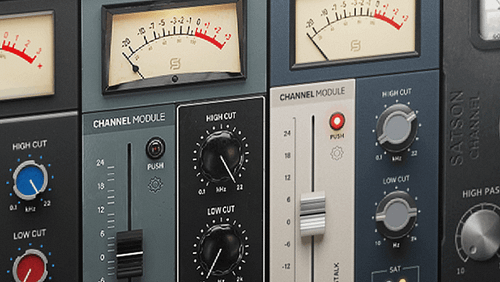When talking about analog hardware and plugin emulations there are always conversations about the sound of a piece of equipment, or the ‘special sauce’ that certain gear adds to the mix, without even moving a single knob. All these refer to what we call saturation and non-linear interactions that analog equipment provides to the sound.
In a previous article, we visited the benefits of adding saturation to the elements of a mix and how plugins like the Burnley 73 can help you shape and add mojo to your sound.
But, what is saturation? Is it different from distortion? And why is such a big part of the musicality from analog hardware? Let’s dig into it and try to find some answers to these questions.
Saturate or Distort?
Strictly speaking, every time a waveform gets altered from its original shape we can say that it’s been distorted. In most fields, distortion is an unwanted change to a signal and so engineers have always strived to minimize it. But the nature and physicality of certain electronic components always cause some changes to a signal as it passes through them. When these changes consist of a subtle addition of overtones to the sound waves, we tend to call this kind of distortion, saturation.
Overtones, also known as harmonics, are whole number multiples of sound frequencies. They provide a unique quality or ‘color’ to the audio and can dramatically change the shape of a waveform. Take something as simple as a sine wave for example, by adding overtones and changing their relationship with the fundamental frequency we can turn this pure waveform into a square, a triangle, or a sawtooth waveform.
The Analog Warmth
When analog gear starts saturating, it adds pleasant-sounding harmonics which can make sounds fuller, punchier, and louder. It also causes a subtle form of ‘soft-clipping’ compression since the louder parts are reduced in volume. The end result of this side effect is a denser and fuller sound that fills the ‘empty spaces’ of the frequency spectrum. It makes sounds exciting, richer, and more interesting. Now imagine what saturation can do for something as complicated as a mix!
Because a mix is such a complex combination of sounds and frequencies, adding saturation creates harmonics that are sonically related to the music. That’s why it does a wonderful job at ‘gluing’ and thickening elements of a song, making mixes more grounded. When used correctly it can even add presence, character, warmth, edge, or cohesion to your audio.
It is such a powerful tool when mixing, it can turn a clean and aseptic mix into a warm, gritty and exciting song. Just like a record!
The Digital Age
Back in the day when everything was done in analog, saturation was taken for granted. It was present in every piece of equipment in the studio – the magnetic tape where the audio was recorded; passing through the console; compressors or equalizers used during mixing. Some console manufacturers even tried to make their equipment as transparent as possible so ‘color’ could be added afterwards by other gear as an artistic decision.
It was in this race to find a cleaner, more transparent, and reliable sound when digital audio came around. When digital recording started in the early ’70s, it ignited a paradigm shift that lingers even today. Recording studios shifted from tape to digital multitrack to the now ubiquitous computer and DAW bundle. But something was missing at the beginning: the sound was clear and lossless no matter how many times you played or recorded over, compared to the old tape; but the mixes were sterile, and engineers were still relying on their analog equipment to make their music sound alive.
That’s when software developers, thanks to modern computer processing, started focusing on emulating and modeling these subtle saturations that analog equipment was adding to the signal. To the point where nowadays, plugins can very much sound like the real thing. Mixing in the box became a reality, allowing anyone to get a professional-sounding mix even from a home studio setup.
Sonimus’ Vision
At Sonimus it’s always been our mission to deliver precise and unique emulations of vintage analog equipment, emphasizing the subtle saturation and non-linear responses that bring music to life. Plugins like Britson or Satson, which bring the 3-dimensional sound and workflow of a console to your DAW; or Sweetone and SonEQ Pro, that add the warmth of a preamp stage to an EQ, are only a couple of examples of how we carefully craft our software to help take your mixes to the next level.
How do you use saturation during mixing? Do you use any of Sonimus plugins as your ‘secret sauce’ to spice your mixes up? Let us know in the comments and share with us some of your tricks and techniques when using analog saturation in your productions.







I use Britson on pretty much every mix, especially on bus channels, and to reduce gain on hot sources as well. I always have it on my master and keep the instance open so I can keep an eye on the VU meters to make sure the overall gain of the mix stays on point which has dramatically improved the quality of my mixes. It’s such a simple plugin, but the results of what it imparts to the mix are undeniable. Really love it.
Very good article guys. Clear, brief and very enlightening.It provides answers to the traditional doubts about the difference between distortion and saturation of analog devices and the way the digital world is getting closer and closer to this warmth. I enjoyed reading it.